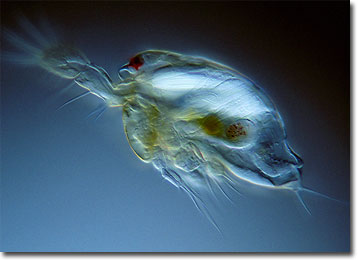Wim van Egmond
Copepod Larva
A class of crustaceans that is comprised of approximately 10,000 species, copepods are generally considered the most abundant multi-celled animals in aquatic environments and are, therefore, sometimes referred to as the “insects of the sea.” These relatives of shrimps, crabs, and lobsters lack compound eyes and carapaces, and are typically quite small, primarily growing between 0.5 and 2 millimeters long.

Copepods are a diverse group that may inhabit a wide array of habitats and exhibit a variety of lifestyles. Most are free-living marine forms, but they may also live in freshwater or damp moss, sand, or soil. Some varieties are even parasites of fish and other animals. Sexual dimorphism may be pronounced in certain species, especially in those that are parasitic. In fact, sometimes the sexes are so distinct that they are not readily recognizable as belonging to the same species. The males of one type of copepod, for instance, are so much smaller than their counterparts that they inhabit a small pouch located within the genital tract of a female.
The reproductive process of copepods varies, but is most often sexual. Egg sacks usually develop soon after copulation and are carried outside of the bodies of females. The number of eggs they contain is species dependent, but they generally hatch into larvae after a period of a few days. These early larvae are referred to as nauplii and may be as little as 20 micrometers in diameter. At first, they possess simple, unsegmented bodies, three pairs of appendages, and a solitary eye. However, the larvae soon undergo a series of five molts, eventually becoming what are known as copepodids. In this form, the developing organisms appear similar to the adults but still lack a full number of limbs, and in parasitic species this is typically the infective stage of the organism. The proper number of limbs and complete segmentation are finally acquired after another series of molts, which results in a sexually mature adult.
BACK TO WIM VAN EGMOND GALLERY
